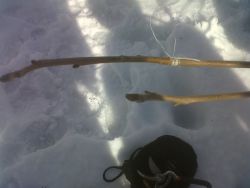Halifax Media Co-op
News from Nova Scotia's Grassroots
Guerilla Grafting in Metro
On Friday some friends and I tapped maples and grafted walnuts. Grafting is a good way to improve the food-value of trees, by creating a tree or shrub with a strong and hardy root-stock and with a topstock that will produce juicy and delicious fruit and nuts
I am tapping two maple trees in my backyard, two of my neighbour's trees and six trees from a generous friend on the Bedford highway. In a week we have gathered a half-gallon of sap. It is my hope to boil it down enough to make wine, which should take less time and energy than it would take to boil it down to the point of being syrup. Any maple can be tapped, as can birches and sycamore. Sugar maples will provide you with the highest sugar-per-sap ratio at 1:40 sugar:water, compared to other maples who have a ratio of 1:45 sugar:water. I am mostly tapping Norway maples, which is much of what has been planted by the city.
The friends who helped me tap in were able to help graft Carpathian walnut scion to black walnut rootstock. This is in the hopes that the Carpathian parts will thrive and produce nuts that are larger and more easily removed from the husk.
Now is the ideal time to start grafting, while the snow is beginning to melt. Traditionally the scion wood (the part you are adding) is removed from the parent-plant around this time, kept in a cool area until the rootstock has advanced in its spring flush. This way, the root stock is more vigorous than the scion wood, and is able to push sap into it vigorously.
We however grafted the wood the same day it was obtained. We used the saddle-graft, where one piece is sharpened on both sides and the other wood has a triangle-shaped chunk carved out of it. In grafting it is very important that the layers of living wood match up between the roostock and scion, so that water and nutrients can continue to be sent through the graft to the living tissue of both host and graft. This keeps the graft alive.
This walnut tree is at the Common Roots Urban Farm at the intersection of Robie and Bell road. Please feel free to check back at the Common Roots Food Forest to see how these grafts progress! We left plenty of Black walnut branches to survive and feed the tree if these grafts don't make it. If the grafts take well, we will trim back the non-grafted branches to maximize energy to the Carpathian limbs.
Here is a good resource if you would like to graft your own walnuts:
https://www.extension.purdue.edu/extmedia/fnr/fnr-105.html
More good information on grafting can be found at Stephen Hayesuk's youtube channel
Comments
I've always been curious
I've always been curious about how guerilla grafting works..thanks for the tips! Curious to see how the tree at Common Roots does.
Sap galore from urban maples
Urban maples tend to give a LOT more sap than sugar bush maples. I live in the sticks but also tap big trees in the open, with BIG canopies. This wasn't a very good year. Do it next year.
I've seen in the US people that tap urban trees on a wide scale. They get permission from the homeowner- and give them a small bottle of syrup at the end of the season.
There are gizmos perfect for big urban trees that you dont get to every day: a sturdy plastic bag that hangs on the tree tap and has a simple little spigot at the bottom.
All the trees I tap have big
All the trees I tap have big crowns and get a lot of sunlight. And there is still a HUGE variation in how much they produce.
If I showed you pictures of the top 4 producers, you probably would not guess which one is the stand out #1. [And it ranks #3 in about size and amount of light... way behind #1 amd #2 in each category.
And many of our trees I eventually stopped tapping over the years- just not worth the work. They dont look any different [altho none of them are large or have very full crowns].
The site for the Halifax local of The Media Co-op has been archived and will no longer be updated. Please visit the main Media Co-op website to learn more about the organization.





